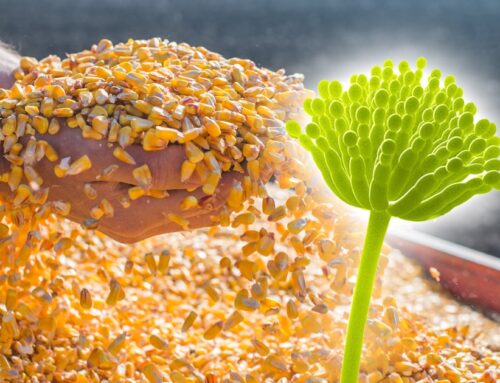Understanding your crop production costs – regardless of the crop you’re growing – is vital. You can’t understand your cash flow or your profitability without first understanding your crop production costs. There are different ways to do it, different tools to use, and different methods to analyze the results. We’re using one tool as a starting point for an example of calculating crop production costs, translating that into break even calculations, and how it all relates to cash flow and your grain marketing plan. In this case, we’re using 750 acres of canola, but the message and theory works for any crop.
Manitoba Agriculture has a CROPPLAN Management Calculator that includes an imaginary farm spreadsheet. It’s worth a download (1.8MB) even if you just use it as a comparison to what you’re doing now to track your crop production costs and projections.
In the Manitoba Agriculture example, they have 750 acres of canola as one of the sample crops. Here’s a summary of how their costs break down for those 750 acres:
- Total operating costs (everything from seed, fertilizer, hired labour, fuel, crop insurance, land rental etc)
- $208,296 ($277.72 per acre)
- Total fixed costs (land and machinery payments)
- $39,500 ($52.67 per acre)
- Total ownership costs (owner withdrawal)
- $12,500 ($16.67 per acre)
For a grand total of $260,296 ($347.06 per acre)
Let’s assume this 750 acres averages 40 bushels per acre, producing 30,000 bushels. To break even on those 750 acres, they’d need an average price of $8.68 per bushel ($347.06 per acre total costs / 40 bushels per acre).
If you download the example spreadsheet, you can play with the numbers and see what happens if fertilizer prices jump up, or your yield exceeds 40 bushels, or you need to use insecticide (which the example didn’t include). Each time something changes, the break even point changes with it. Creating different scenarios (including a best case and worst case) lets you make better decisions throughout the year.
Knowing your “Break Even” helps you predict profit
When you put all your crop production costs together and calculate your break even point, decisions about selling your grain for a profit get easier. Let’s say it’s spring and you’ve just finished seeding those 750 acres of canola. You have your projected costs and break even point calculated. You receive a bid for canola at $10.65 per bushel from ACME Grain in Dog River (thank the Manitoba Agriculture tool for the Corner Gas reference!)
You might have no idea where canola prices are going this year, but because you have a good handle on your costs and your break even point, you can see that this is likely a profitable offer for you.
Is it possible you’re leaving money on the table because a better price might come later in the year? Yes. But it’s also possible that it’s the best price you’ll see all year. And, based on your calculations, it is a price that generates an almost $2/ bushel profit for that crop.
Cost projections also build a path to healthy cash flow
You can calculate every acre of your farm to be profitable, but if you have poor cash flow, you’re in trouble. In fact, many farms turn a profit on the books but struggle to make ends meet during certain times of the year because of cash flow problems.
Cash flow is the balance between the cash coming in and the cash leaving your operation. Cash flow management isn’t just about the amount of cash, it’s also about the timing of that cash.
The Manitoba Agriculture tool we talked about in the break-even analysis doesn’t provide a cost breakdown over time. But, that is what you need. Because, once you have a handle on total projected costs, you need to understand when throughout the year those costs come due. You then need to compare that to when you have cash coming in throughout the year. Where are the gaps, and how big are they?
Here are some cash flow questions to consider – that are easier to answer when you know your costs.
- When are the times of year when my need for cash is highest? Lowest?
- Are there ways I can spread around some of the costs more evenly throughout the year?
- Can I spread my grain sales throughout the year to reduce price risk and match some of my cash output demands?
- If I don’t sell grain to match my cash requirements during certain times of year, how can I finance those expenses (loans, lines of credit, savings etc)? What are the interest costs for that that financing?
The grain sales plan
Your crop production costs are connected to your cash flow requirements. Your cash flow requirements are connected to your grain marketing / sales plan. Once you understand your costs and cash flow requirements then you can be more consistent with a grain marketing (sales) plan.
Have a conversation with your accountant to determine the best way to create your grain sales plan. Does it make more sense for your farm to create target revenues by commodity? Target revenue by month? By commodity by month? When making that decision, keep in mind that not all commodities act the same and that diversity is exactly why you need a disciplined plan.
Plan for change – like high fuel prices this summer
Understand that plans can change. There are factors outside of your control that impact your revenue and expenses, so you need to stop and review the plan periodically and adjust as things happen. As an example, we heard predictions over the winter of high fuel prices going into the summer. Today we see those predictions coming to fruition and they are even higher than I expected. Fuel is a huge expense, so when seeding is done on our imaginary 750 acres of canola, it’s a good time to review the fuel and oil expenses and adjust them.
Keep it simple
Google “understanding your costs.” Go ahead! You’ll be overwhelmed with the number of hits! 841 million Google results in 0.48 of a second. There are lots of perspectives and different ways to slice and dice business costs and crop production costs. This shouldn’t be overwhelming because it’s important and needs to be done. Work with your accountant and bookkeeper to create a very do-able but meaningful system for your farm. Use the cost and break-even information to create your marketing plan. And once you have your marketing plan in place, it’s easier to make decision about selling your grain. Once you know what price you want for your imaginary 750 acres of canola, you can use tools like CXN360 to either monitor for prices or create a target to find buyers who’ll match your terms.




